
Germany - diesel multiple units and railbuses of DB AG
For a full scale picture, please click on the picture shown !
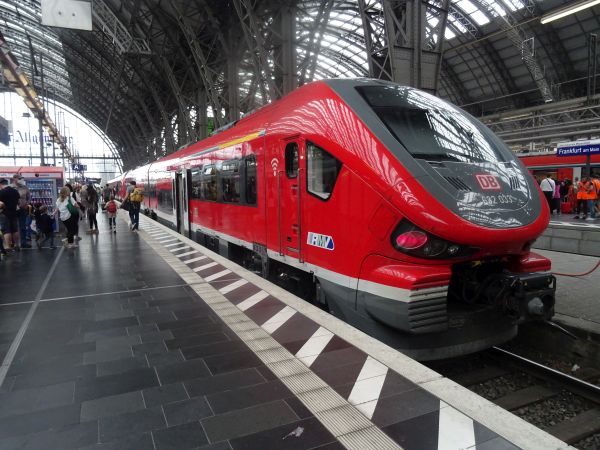
This class Br632 diesel multple unit is an example of DB buying trains from abroad with no luck. In 2014-15 DB was pretty mad at its normal
train producers, such as Siemens, Alstom and Bombardier, because of the repeated long delays in delivering promised trains. So as a kind of
a revenge, they decided to buy two batches of trains from elsewhere: the Nürnberg-München high speed RE trains from the Czech republic and
these local trains from Pesa in Poland. That was a big mistake. These trains belong to the Pesa Link family. DB ordered trains in one, two
and three coach varieties (Baureihen 631-633). But it took an incredibly long time to get them approved for traffic in Germany, with some
very basic problems (e.g. they were shown to be about 2cm wider than is accepted, they were heavier than agreed, had less power than agreed,
their bogie fittings failed, they had a tendency of resonating, which led to a very unruly sideways movement during the ride, which passengers
hated etc etc.) and they were, and still are, ridden with all kinds of software problems, making them very unreliable. Passengers just simply
hate them. One private German company already a long tme ago terminated their agreement to buy similar trains and returned them to the
manufacturer as useless.
This picture shows the two-coach variant, Br632 at Frankfurt Hauptbahnhof 3.6.2022.
Picture by Ilkka Siissalo.

The front part of a three-coach Pesa Link train, Br 633.
Picture from Frankfurt Hauptbahnhof 3.6.2022 by Ilkka Siissalo.
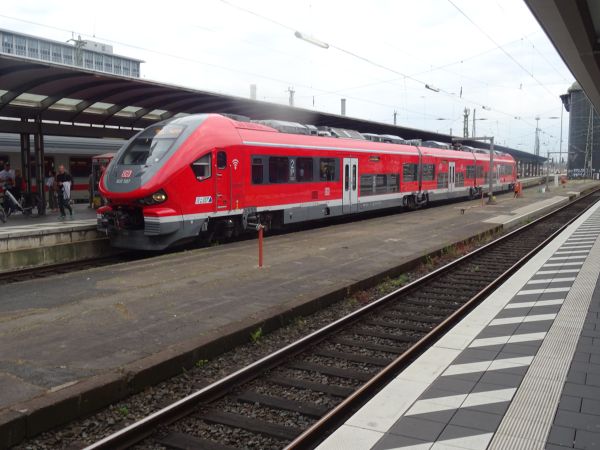
A full view of a three-coach Pesa Link train, Br 633.
Picture from Frankfurt Hauptbahnhof 3.6.2022 by Ilkka Siissalo.
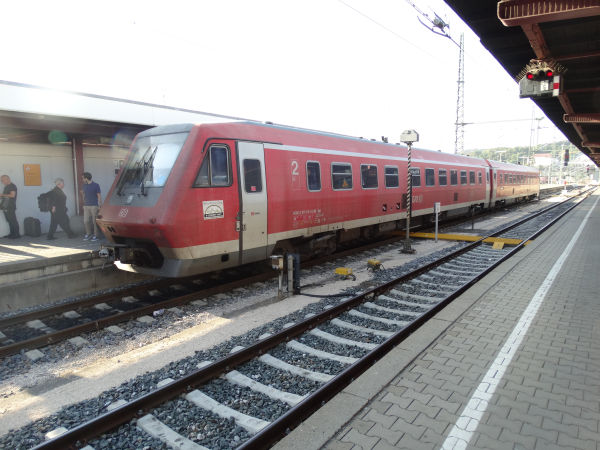
The class 611 was not a success. First DB bought actively tilting diesel trains, so called RegioPendolinos, from the Italian Fiat. They
became the DB class 610. When DB wanted more of them, a public tendering was arranged and it was won not by Fiat, but by an East German
factory which by then was called LEW Hennigsdorf. It was the time right after German reunification and for the politicians it was
important to get more work for the people in the east, so a contract was signed. But the Br 611 has become famous for its constant
defects and noisiness and even when it is working, some people complain that one becomes seasick because of its too active active tilting.
But they still existed until at least the end of 2018. The Fiat class 610 is already out of service since a long time.
Picture from Ulm 13.9.2016 by Ilkka Siissalo.

Same train as above. The actively tilting Br 611 was a typical product of the early 1990s.
Picture from Ulm 13.9.2016 by Ilkka Siissalo.

Still the same Br 611 train seen from the other side.
Picture from Ulm 13.9.2016 by Ilkka Siissalo.
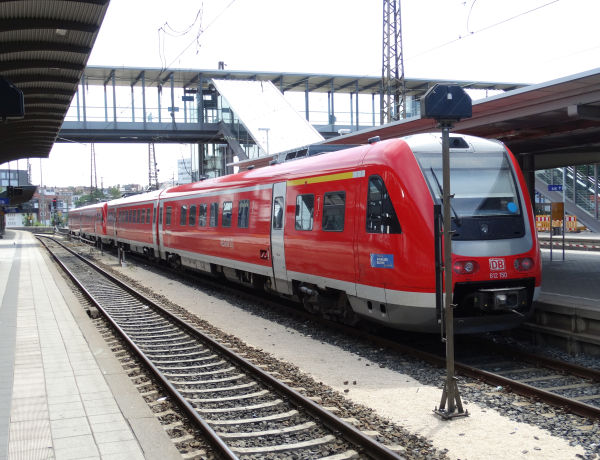
Br612 "RegioSwinger" is a diesel powered tilting train intended for fast regional express services on non-electrified lines.
They are used especially in Bayern (Bavaria) and in the Saarland area in the west. These trains were built by ADtranz, now
Bombardier, since 1998. 192 trains were built. Since the Br612 is just a two-coach composition, they are most often seen
as combinations of two units, just like here. This model is a further development of the not so successful Br611 shown above.
Picture from Ulm 3.7.2019 by Ilkka Siissalo.
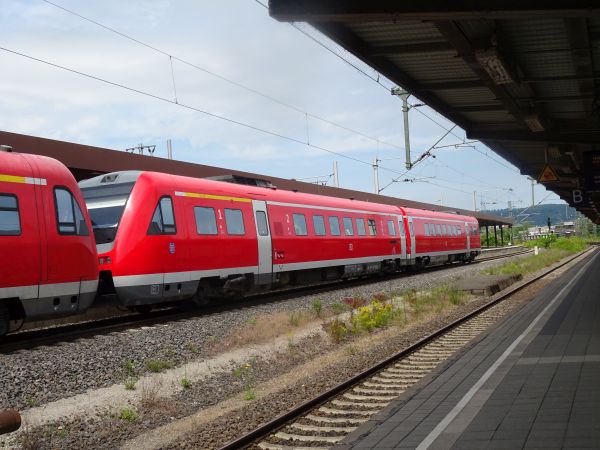
Another Br612 RegioSwinger. In this case the train consisted of three pairs of BR612.
Picture from Göttingen 3.6.2022 by Ilkka Siissalo.
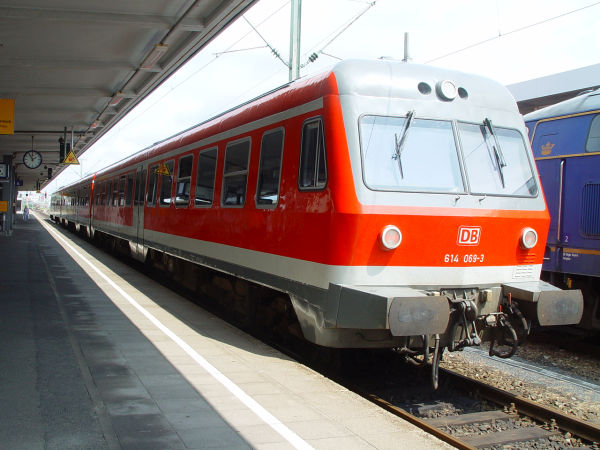
More memories from times gone by. These Br614 trains do not exist any more, except for (I believe) only two examples in railway museums in
Germany. But these were really commonplace once. This Br614 diesel multiple unit is a direct successor and technically very similar
with the earlier Br624 (note that the numbering does NOT give any idea of what is newer or older !). These had MAN engines and were built
together with MAN and Uerdinger Waggonfabrik. Production began in 1973 and they were originally designed for actively tilting bogies -that's
why the chassis is narrower towards the roof. Most of these trains were stationed at Braunschweig, Nürnberg or Trier. They were all taken
out of service until 2010.
Picture from Braunschweig Hbf 22.7.2004 by Ilkka Siissalo.
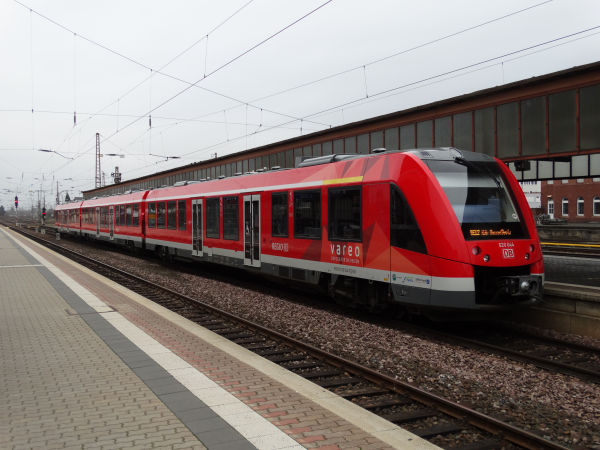
There are still quite a lot of unelectrified rail lines in Germany
where diesel traction is needed. This section of our archive shows DB's diesel railbuses and diesel multiple units.
Our first picture shows one of the very newest DMUs, a class 620 three coach train of the "Vareo" service.
Class 620 comes from the French company Alstom and it is Alstom's type Coradia LINT 81. Picture at Trier main station
18.12.2016 by Ilkka Siissalo.
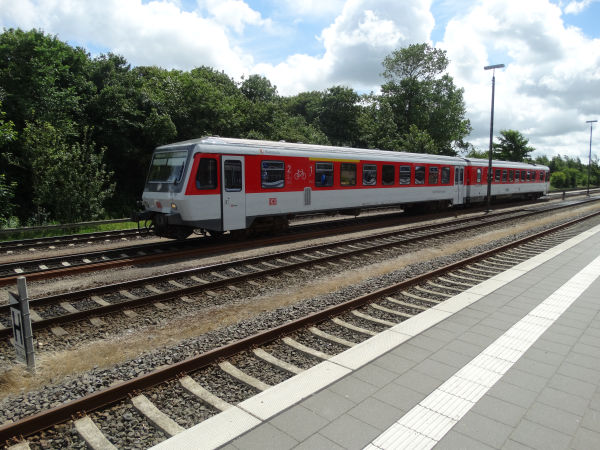
This is a class 628 diesel railbus, but not painted red as usual, but instead in the "long distance train colours" and named
"Sylt Shuttle Plus". There is only a train connection between the mainland and the island of Sylt. Cars are transported by train
and DB runs there a service called Sylt Shuttle between Niebüll on the mainland and Westerland on the island. But in 2015 it
was announced that there would be a new competitor for DB in this profitable traffic. To block the competitor from gaining access
to the rail slots, DB added to its Sylt Shuttle trains these two coach old railbuses, which would run combined with the car
shuttle trains between Niebüll and Westerland, but which are then detached at Niebüll and continue as "long distance trains"
or "express trains" further
inland to the town of Bredstedt. This is a slow and useless service and almost nobody needs to use it, but it allowed DB to
classify its Sylt Shuttle trains as valuable long distance passenger express trains, which have priority over a potential competitor's
car shuttle trains. A dirty trick - but it seems to have worked. The competitor has by the end of 2016 been able to run only a
few car shuttle trains. Picture at Niebüll station 9.7.2016 by Ilkka Siissalo.

A car shuttle train has just arrived from the island of Sylt to Niebüll station and at the end of it hangs the old Br 628 railbus
as "Sylt Shuttle Plus". Soon it will be detached, then it will run to the passenger platform and finally continue further inland
to Bredstedt. DB has masses of these old Br 628 railbuses doing nothing as they have been replaced by more modern trains, so it
doesn't cost them much to waste a couple of them in this way to cause harm to a competitor.
Picture at Niebüll station 9.7.2016 by Ilkka Siissalo.
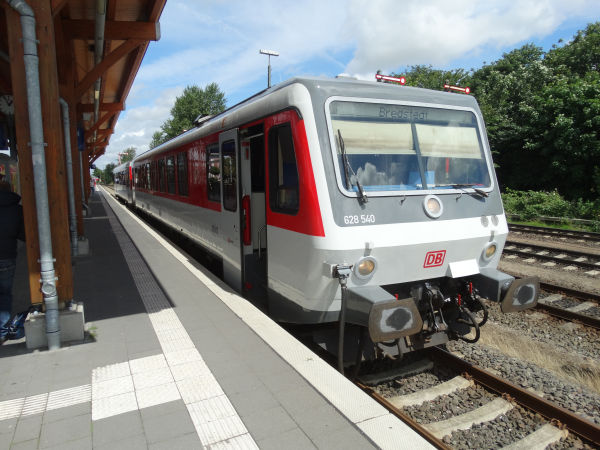
Here the Sylt Shuttle Plus railbus has come to the passenger platform at Niebüll and is soon ready to continue towards Bredstedt.
There were only two passengers on board.
Picture from Niebüll station 9.7.2016 by Ilkka Siissalo.
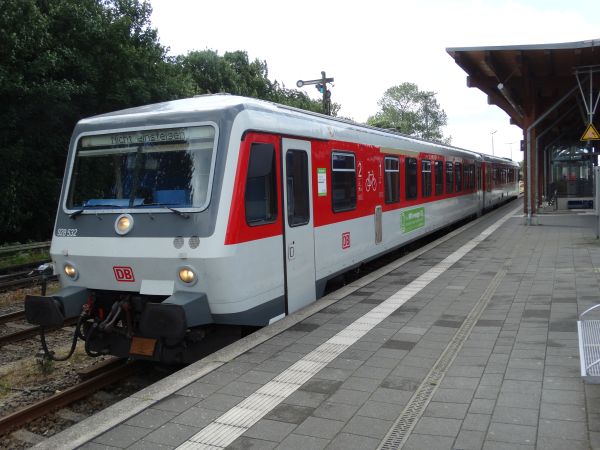
One more Br628 railbus in InterCity colours, running the Sylt Shuttle Plus service
Picture from Niebüll station 5.7.2024 by Ilkka Siissalo.
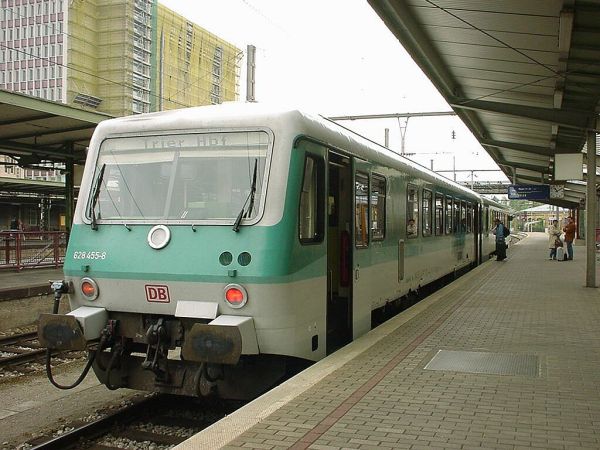
This is now already history from long time ago. Regional trains between Trier in Germany and the city of Luxemburg were run by Br628
railbuses. Some of these railbuses were owned by DB and some by the Luxemburg state railways CFL, but all of them carried the colours
of DB's local/regional trains and all were serviced by DB in Germany. In this picture one of these Br628 trains is waiting for its
departure time at the station of Luxemburg. This individual unit carried DB's logos, some other units looked otherwise the same, but
carried the logos of CFL at their fronts.
Picture from Luxemburg station 12.3.2002 by Ilkka Siissalo.
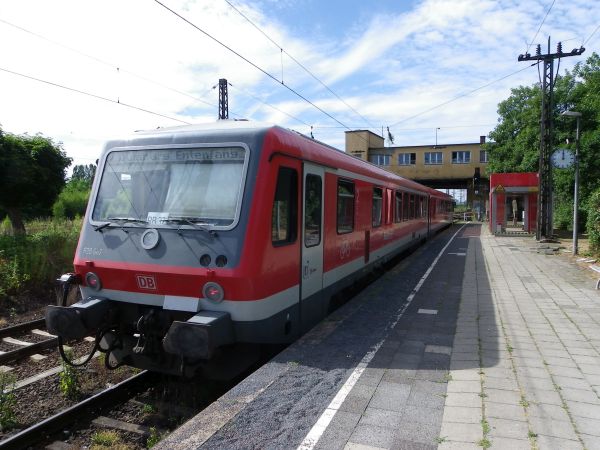
One of the newest versions of Br628 railbuses, subclass Br628.400.
Picture from the station of Duisburg-Wedau 7.7.2010 by Ilkka Siissalo.
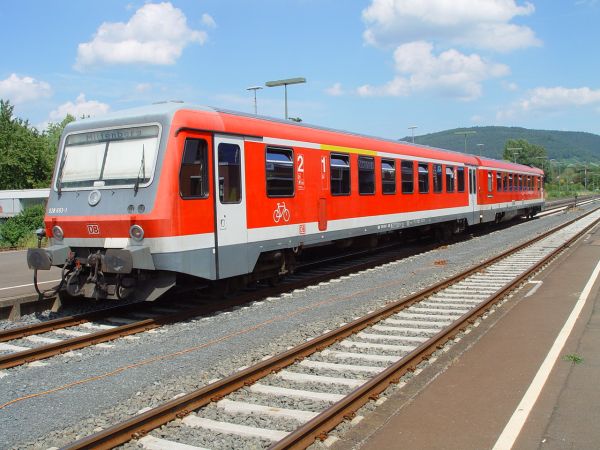
A similar Br628.400 train as shown above.
Picture from the station of Miltenberg 21.7.2004 by Ilkka Siissalo.

Compare this train with the one pictured above! This was one of the so-called zero series of the class Br628, one of only a handful
of prototype railbuses of the class Br628, whereas the train pictured above is one of the very newest Br628 machines from the fourth
series. There's quite a difference! These old zero-series Br628 trains used to run for many years from München uphills towards
Austria and over the border to Reutte in Tirol. But these are all scrapped by now.
Picture from München Hauptbahnhof (Munich main station) 14.6.2002 by Ilkka Siissalo.
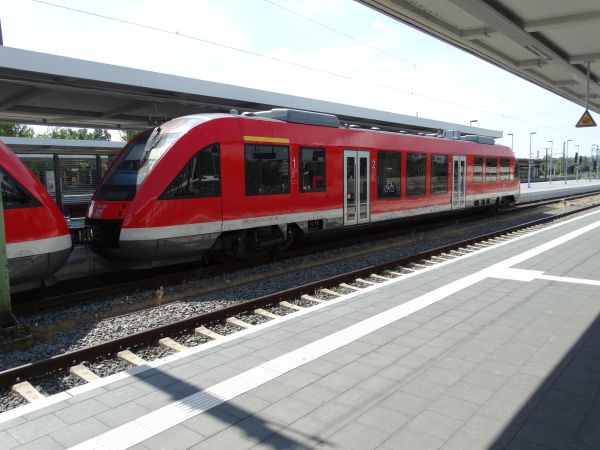
Alstom Coradia LINT railbuses are available also as one coach variants called LINT 27 or Br640.
Picture of a Br640 railbus is from Braunschweig 17.7.2018 by Ilkka Siissalo.
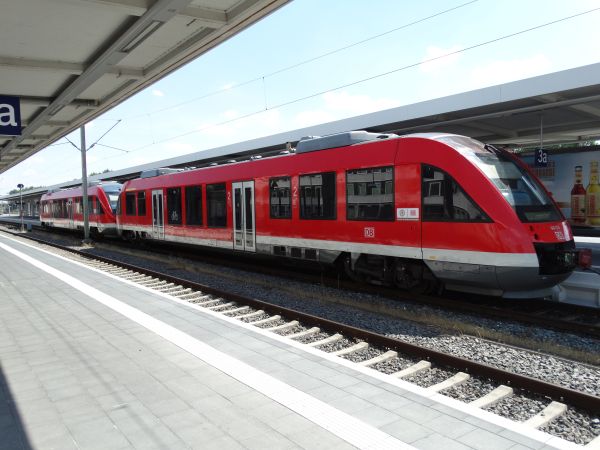
Another view of two class Br640 railbuses.
Picture from Braunschweig 17.7.2018 by Ilkka Siissalo.
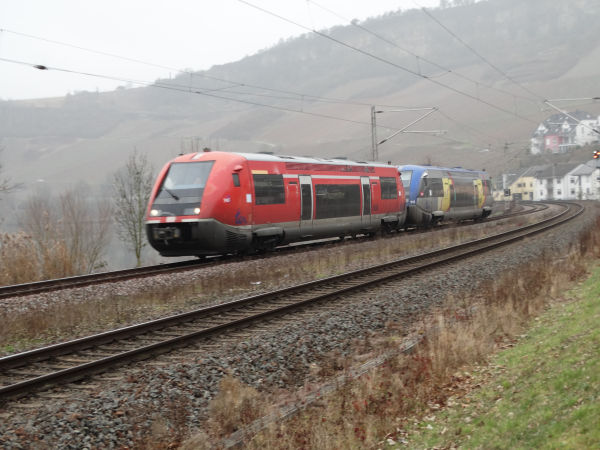
This picture shows a real rarity. These are Alstom made French railbuses nicknamed Baleine, blue whale. Officially the type
is called Alstom Coradia A TER and DB calls in in Germany Br 641. But these two are French trains running here in Germany
and one of them is in DB's red paintings, but with French SNCF's stickers, and the other one is in SNCF's blue and grey livery.
The explanation lies in an agreement between the German state of Saarland and the French administrative region of Lorraine
regarding regional train traffic across the border. Saarland bought some of these railbuses and they were painted DB's red and
SNCF bought other ones painting them in their own typical way. The red ones are officially DB's class 641 railbuses, but they all are
operated and maintained by the French SNCF.
Picture from the small station of Nittel by the river Mosel 17.12.2016 by Ilkka Siissalo.
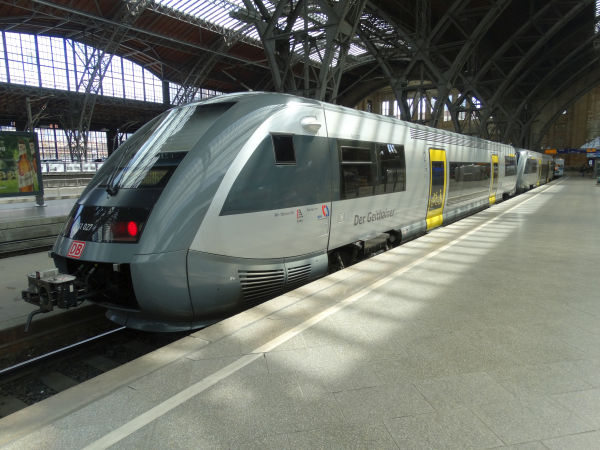
Some of the same "Baleines" were transferred from Basel region and from Saarland to Eastern Germany. These two are in the grey regional
colours of Mitteldeutschland, the S-Bahn network around Leipzig, and they have been named as "Der Geithainer" as they are connecting
Geithain to Leipzig.
Picture from Leipzig Hauptbahnhof 16.7.2018 by Ilkka Siissalo.
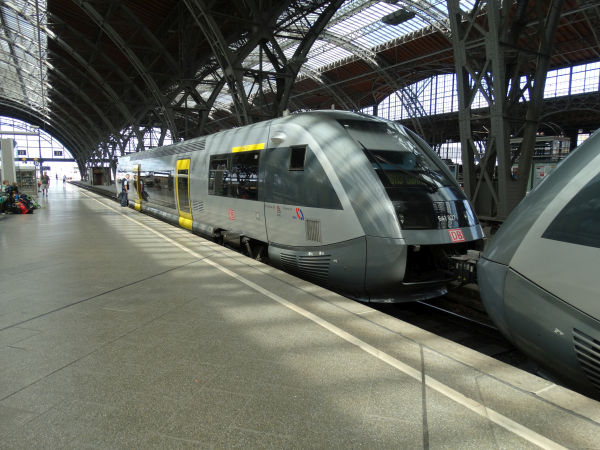
Another view of a class Br641 "Baleine" as "Der Gaithainer" in Leipzig.
Picture from Leipzig Hauptbahnhof 16.7.2018 by Ilkka Siissalo.
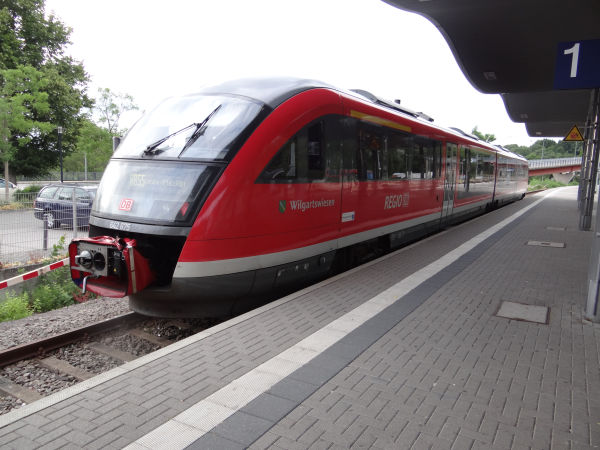
Compare with the picture of Br643 below. This was a competing product. This is a Siemens Desiro two coach long diesel railbus of the class
642. These two types are easy to mix up, but the opening at the front where the Scharfenberg coupling comes out is broader in the
Siemens Desiro train, which makes it look more like "broadly smiling".
Picture from Pirmasens station 8.7.2015 by Ilkka Siissalo.
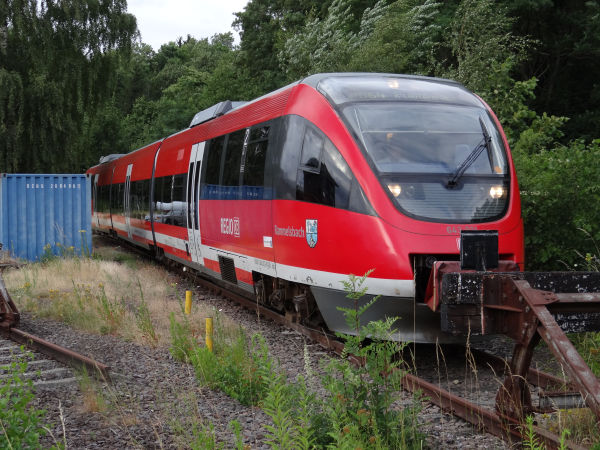
This is a three coach long diesel railbus made by the company Bombardier. It is a Bombardier Talent (1st generation), class 643.
Picture from Pirmasens station 8.7.2015 by Ilkka Siissalo.
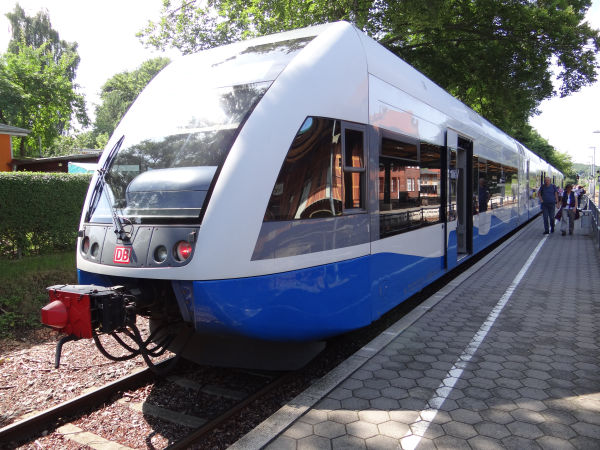
This is an UBB, Usedomer Bäderbahn, railbus of the DB class 646, which is a Swiss Stadler built GTW 2/6. The UBB is a daughter company
of DB and it operated the Bäderbahn or "railway for the bathers" along the sandy shorelines of the famous holiday island of Usedom
on the Baltic sea coast of eastern Germany.
Picture from Seebad Ahlbeck station 2.7.2013 by Ilkka Siissalo.

Two RegioShuttle RS1 railbuses of DB subsidiary RAB (DB ZugBus Regionalverkehr Alb-Bodensee) at Ulm station.
RegioShuttle was developed by the company ADtranz, but after its insolvency, the rights were transferred to the Swiss company
Stadler. Stadler has developed this model into a real success, especially within the market segment of small private rail companies.
It's rare though to see an RS1 in DB red.
Picture from Ulm 13.9.2016 by Ilkka Siissalo.
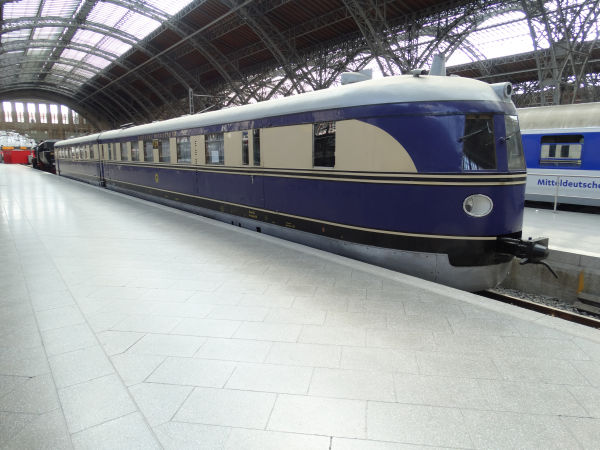
In pre-war Germany speed was very important for the Nazi government. German Reichsbahn DRG built a series of very fast diesel trains
which were classed as SVT 137. There were four subclasses of these very fast trains. This one, SVT 137.225 is of the so called
Bauart Hamburg subclass. It was a two section railbus with Jacobs bogies, had a power rating on 604kW and a maximum speed of 160 km/h. These
were used in the Berlin to Hamburg traffic. After the war this one ended up in communist DDR and served there as a special train of
the top state politicians. Now it is restored to its original paintings and is kept as a memorial at Leipzig main station.
Picture from Leipzig Hbf 16.7.2018 by Ilkka Siissalo.

Same SVT 137 as above, but seen from the other side.
Picture from Leipzig Hbf 16.7.2018 by Ilkka Siissalo.
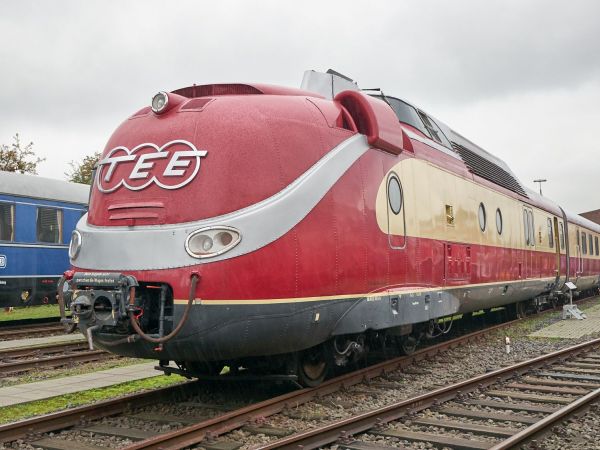
This famous Trans Europ Express TEE diesel train was based on the pre-war technology of the SVT 137 diesel railcars, one of which is shown above.
This one was classed as DB class VT 11.5, later class 601, of which 19 trains were built in 1957. It was a first class only train which had 122
seats plus 46 seats in the dining area. Its maximum speed was 160 km/h. They were used on TEE routes from Germany to Paris, Amsterdam, Oostende
and Zürich.
Picture from the DB museum in Koblenz-Lützel 30.9.2017 by Kyösti Isosaari.

This is also a famous train. It's the former East German DR's famous railbus, nicknamed "Blutblase" (bloody blister) or "Ferkeltaxi"
(piglet taxi). Officially it was first called VT 2.09, later DR's class 171 or 172 and after the merger of East German DR and West German DB
into DB AG, this became Br 771 or 772. They were built by Waggonbau Bautzen 1962 to 1969. It has a small diesel engine with a modest
power output of only 132 kW and a hydraulic system for power transmission. Its top speed is 90 km/h.
Picture from the railway museum Gramzow 6.4.2017 by Ilkka Siissalo.
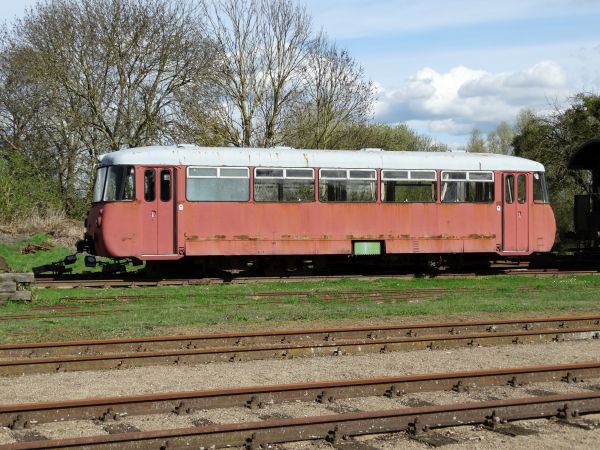
Another similar Br 171 "Ferkeltaxi". This one is still waiting for a major rehaul.
Picture from the railway museum Gramzow 6.4.2017 by Ilkka Siissalo.

A beautifully restored and repainted "Ferkeltaxi" maked with its old communist DDR time class number of Br171.
Picture from the traffic museum in Dresden 2.7.2024 by Petteri Holopainen.
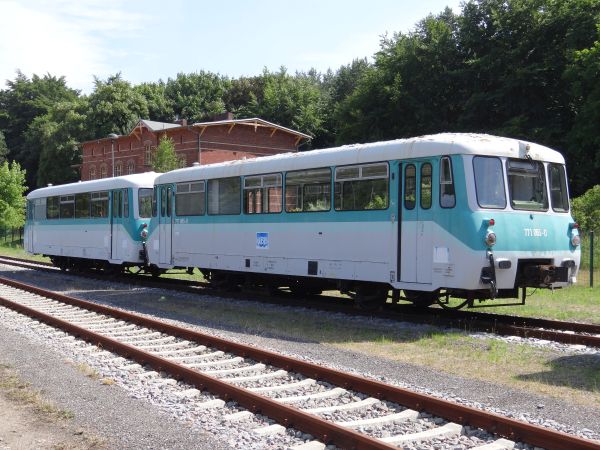
After the German reunification DB AG modernised many of the old East German "Ferkeltaxis" and they were painted in the mint green and grey
scheme which was by then the new standard. Ever since the new nickname for these trains was "peppermint candy". This train belonged
to the UBB, Usedomer Bäderbahn, subsidiary of DB on the island of Rügen. This motorwagon belongs to the class Br771.
Picture from Seebad Ahlbeck on the island of Rügen 2.7.2013 by Ilkka Siissalo.

The old East German Br171 "Ferkeltaxi" railbuses were heavily modernised in the beginning of the 1990s, as discussed above. But after
these modernisations they were split into two classes, Br771 and Br772. They looked exactly the same on the outside. Compare this 772
with the 771 shown just above. The only visual difference was that the 772 had on its outside a sticker announcing that it had been
remotorised with a western MAN engine. It seems though that the key
difference between these two classes was only that class 772 motorwagons could be remotely controlled from either another motorwagon or
a motorless driving trailer wagon, whereas the class 771 which was not capable of being remote controlled, was typically used just
alone or then just with a motorless trailer wagon of the class 971. The class 971 trailers had neither engines nor driver's cabs.
Here we see a class 772 motorwagon combined with a driving trailer, an engineless trailer wagon which however did have a
driver's cab so that the motorwagon could be remotely controlled from there.
Picture from Zinnowitz 2.7.2013 by Ilkka Siissalo.
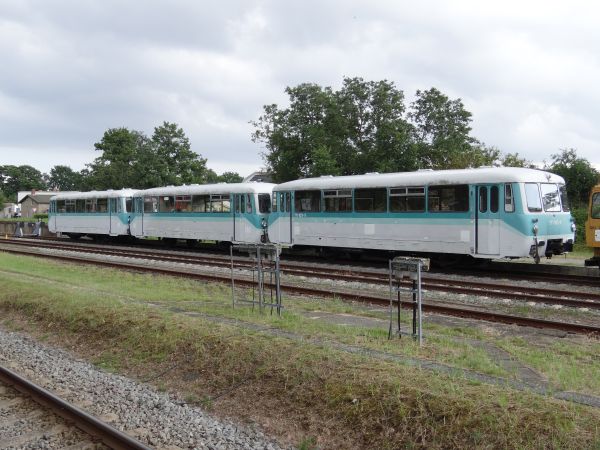
Having said all of the above, it seems though that at least Usedomer Bäderbahn UBB used its Br771 railbuses also like this.
Here we see two Br771 motorwagons "in sandwich mode" with a motorless Br971 trailer coach in between. Whenever the train needed to
change direction, the motorwagon at the end of the train would just simply be turned off and it rolled at the end like a motorless
trailer wagon.
Picture from Zinnowitz 2.7.2013 by Ilkka Siissalo.

These Br672 railbuses were designed to be the low-floor successors of the old East German "Ferkeltaxi" railbuses shown above.
The were built by Deutsche Waggonbau DWA as their type LVT/S and they were first operated by the private train operator KEG, Karsdorfer
Eisenbahn Gesellschaft. After KEG went bankrupt the federal DB AG took over them and has been operating them as Burgenlandbahn of DB Regio
under the new type name Br 672. Here we see one of them still in KEG's yellow and grey livery. Some of these same trains operate now
also for Hanseatische Eisenbahn and Eisenbahngesellschaft Potsdam in their local passenger traffic.
Picture from Merseburg station 21.7.2007 by Ilkka Siissalo.
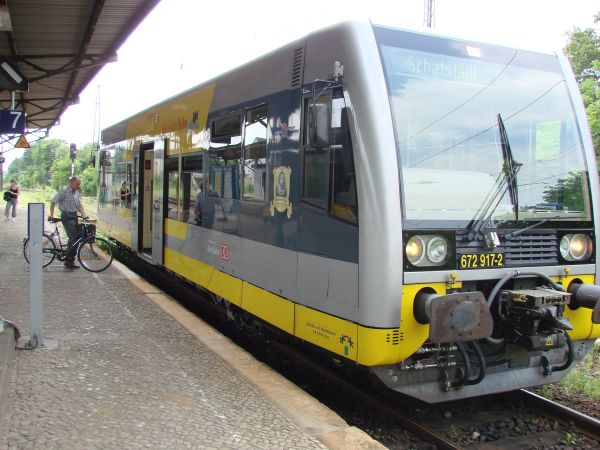
Another DB Regio Burgenlandbahn Br672 is boarding a man and his bike.
Picture from Merseburg station 21.7.2007 by Ilkka Siissalo.
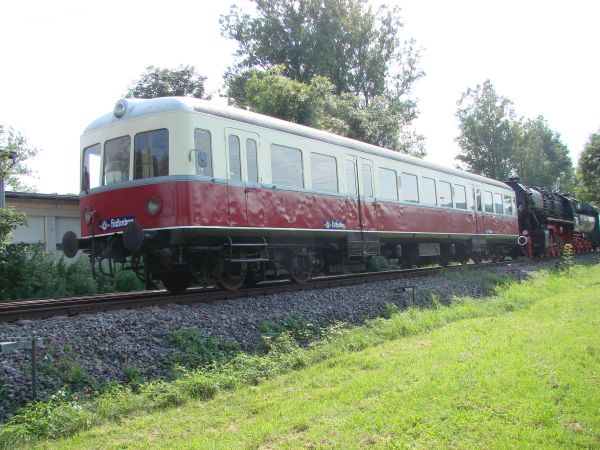
This historic railbus is the VT61, a type built by the Maschinenfabrik Esslingen as one of the so called "Esslinger Triebwagen".
The famous small railbuses of Br 795/798 were designed for small sidelines with less passengers, but these Esslinger models were intended
for the heavy suburban traffic of industrialised cities, especially those of the southern part of Germany. This Esslinger in the picture
is about 10 meters longer than any one of the classic sideline railbuses. It had 80 seats and a top speed of 80 km/h, which at the
conditions of post-war Germany was a lot. This one Esslinger VT61 in the picture was built in 1952.
Picture from the so called Sauschwänzlebahn at Blumberg 18.7.2007 by Ilkka Siissalo.
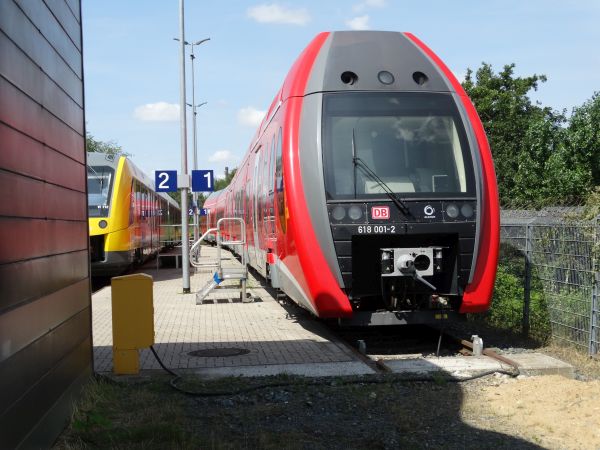
This one is the Baureihe 618 and it is the only one of its kind ever built. It was a prototype and technology trial platform. Totally low-floor,
with most of its machinery on the roof. It had six coaches, which were shorter than normal train coaches usually are. No bogies, just individual
axles. It had a mechanism which tried to predict the next curve and which could slightly turn an axle in the right direction. This prototype
was used in former East Germany mainly between Magdeburg and Wittenberge as a Regionalexpress. The train was built in the year 2000 and it was
used until 2006. It was produced by the company Alstom at the former Linke-Hoffman-Busch factories in Salzgitter and it stands now as a monument
on the factory area of Alstom in Salzgitter. Alstom called this train Alstom Coradia LIREX.
Picture from Alstom in Salzgitter 14.7.2023 by Ilkka Siissalo.

